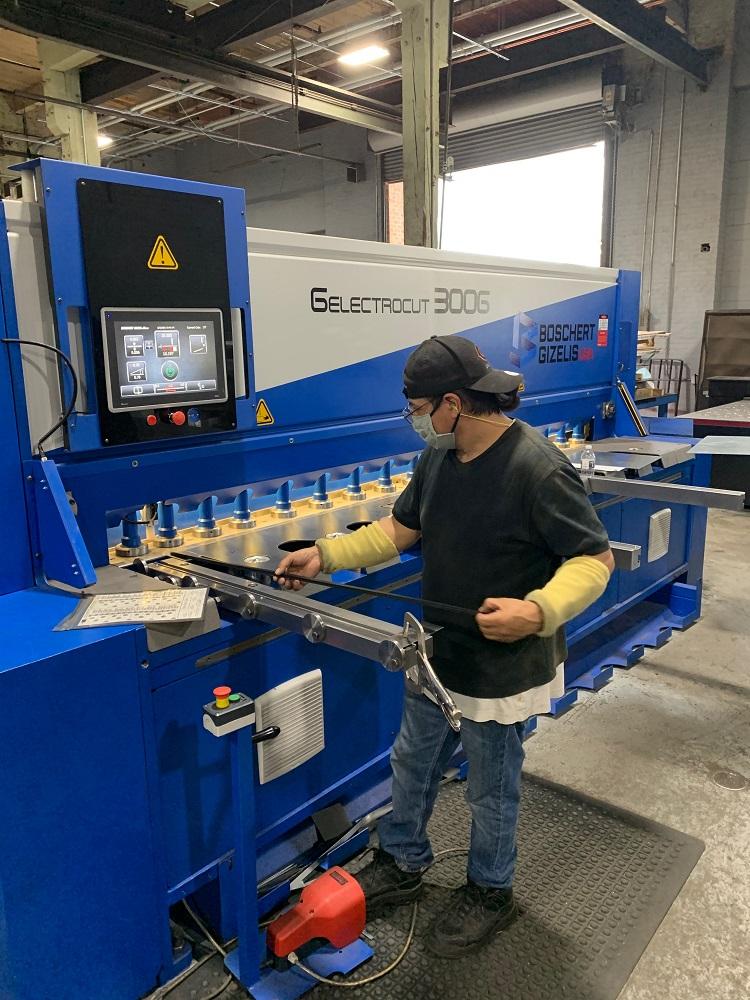- FMA
- The Fabricator
- FABTECH
- Canadian Metalworking
Categories
- Additive Manufacturing
- Aluminum Welding
- Arc Welding
- Assembly and Joining
- Automation and Robotics
- Bending and Forming
- Consumables
- Cutting and Weld Prep
- Electric Vehicles
- En Español
- Finishing
- Hydroforming
- Laser Cutting
- Laser Welding
- Machining
- Manufacturing Software
- Materials Handling
- Metals/Materials
- Oxyfuel Cutting
- Plasma Cutting
- Power Tools
- Punching and Other Holemaking
- Roll Forming
- Safety
- Sawing
- Shearing
- Shop Management
- Testing and Measuring
- Tube and Pipe Fabrication
- Tube and Pipe Production
- Waterjet Cutting
Industry Directory
Webcasts
Podcasts
FAB 40
Advertise
Subscribe
Account Login
Search
Fire suppression systems manufacturer updates press brakes for speed, safety
- November 5, 2020
- News Release
- Bending and Forming
Situation
Founded in 1955, Safe-Air Dowco, Cicero, Ill., makes air distribution products, primarily concerning safety. “We make fire-rated products that are designed to close in the event of a fire,” said General Manager Jason Angio. “Basically, we produce the guts inside of the equipment to regulate airflow—eliminating or slowing down the process of feeding fires with oxygen.”
Safe-Air’s mechanical press brakes and shears had served the company well over the decades, but the company was facing an entire gamut of challenges associated with old-school manufacturing and aging equipment: safety concerns, noise, poor accuracy and speed, and changeover issues. Workers often had to move material from one brake to another to make a series of bends, creating a bottleneck.
It was time for a change.
Resolution
With equipment investment funding from its new parent company, Houston-based Nailor Industries, Safe-Air had the capital to upgrade its equipment, resolve efficiency challenges, and increase its productivity. The company purchased three Boschert Gizelis machines from Boschert USA—a G-Bend Plus 3140 hydraulic press brake, an ElectroBend 3100 electric press brake, and an ElectroCut 3006 electric shear—after an equipment demo convinced Angio that Safe-Air was on the right track.
“I was impressed with the quality and speed,” he said. “I had expected the performance, but I didn’t expect the safety measures built into all three machines.”
And those safety features were of the utmost importance. “Unfortunately in the recent past, we’ve had some injuries on the mechanical press brakes,” Angio explained. “But you physically can’t get hurt on the new machines.” The press brakes and shear are equipped with light curtains that prevent injuries. If anything other than the material crosses the light-curtain barrier, the machine shuts down.
Improved output is another benefit. Since the G-Bend Plus was installed in 2018, sales have increased 280%, and the company credits improved speed and accuracy in the shop. The former bottleneck issues have been eliminated, and pressure now is on the assembly step.
“Where we once had challenges waiting for completed metal parts, it now takes me three times longer to assemble than to cut and bend,” Angio said.
The new machines’ capabilities have allowed the shop to take on jobs that weren’t possible in the past. “We can now circle back to projects we had to turn down and now we can do them easily, quickly, and fast, and at a competitive price,” Angio explained.
Power consumption is another benefit. The two Electro series machines are electrically powered, consuming 50% less energy than hydraulics because they use no power when at rest. And because there is no need for hydraulic fluids or oils, they are better for the environment and eliminate waste.
Finally, Angio has received nothing but positive feedback from the machine operators. All have reported a smooth transition in learning to use the new machines.
Related Companies
subscribe now

The Fabricator is North America's leading magazine for the metal forming and fabricating industry. The magazine delivers the news, technical articles, and case histories that enable fabricators to do their jobs more efficiently. The Fabricator has served the industry since 1970.
start your free subscription- Stay connected from anywhere

Easily access valuable industry resources now with full access to the digital edition of The Fabricator.

Easily access valuable industry resources now with full access to the digital edition of The Welder.

Easily access valuable industry resources now with full access to the digital edition of The Tube and Pipe Journal.
- Podcasting
- Podcast:
- The Fabricator Podcast
- Published:
- 04/16/2024
- Running Time:
- 63:29
In this episode of The Fabricator Podcast, Caleb Chamberlain, co-founder and CEO of OSH Cut, discusses his company’s...
- Trending Articles
Capturing, recording equipment inspection data for FMEA

Tips for creating sheet metal tubes with perforations

Are two heads better than one in fiber laser cutting?

Supporting the metal fabricating industry through FMA

Omco Solar opens second Alabama manufacturing facility

- Industry Events
16th Annual Safety Conference
- April 30 - May 1, 2024
- Elgin,
Pipe and Tube Conference
- May 21 - 22, 2024
- Omaha, NE
World-Class Roll Forming Workshop
- June 5 - 6, 2024
- Louisville, KY
Advanced Laser Application Workshop
- June 25 - 27, 2024
- Novi, MI


























